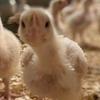A bird's eye view: the chicken visual system

- Other chickens.
- Predators.
- Another chicken's intentions (which allows birds to avoid unwanted aggression).
- Location of resources, such as food and water.





- Chickens have better acuity in brighter lit environments.
- Conversely, chickens have less acuity when in a dimly lit environment.
- When comparing chickens to humans, we are able to see with much higher acuity than chickens are able to see.

- Monocular vision means that separate images are received from the retina of each eye, while binocular vision means that images from both eyes overlap.
- Chickens can see a total of 300 degrees around them, with only 30 degrees of that being binocular. Monocular vision is common in prey species, so they can see predators in their surrounding environment.
- A large field of binocular vision allows animals to develop strong depth perception.
- Humans and other predators often have good depth perception because our eyes are forward facing on our heads, allowing for more binocular vision. Binocular vision is common in predator species so they can locate prey.
- It is thought that the small area of binocular vision is likely not enough to provide chickens with depth perception.
- Photoperiod: Birds need a minimum of at least 6, preferably 8, hours of complete darkness.
- Intensity: Although chickens see better in bright light, brightly lit environments contribute to damaging behavior such as feather pecking and cannibalism (see PEC newsletter vol. 7 Injurious pecking).
- Flicker: Poultry can see flicker associated with bright fluorescent lighting.

- It is important to provide birds with periods of darkness:
- Typically young chicks prefer to rest in brightly lit areas.
- As the birds age, they prefer to rest in dimly lit areas and reserve the brighter areas for time they spend active.

Y.A. Kram, S. Mantey, J.C. Corbo, 2010. Avian cone photoreceptors tile the retina as five independent, self-organizing mosaics, PLoS One. 5(2): e8992.
ONCE. 2020. Experience healthier and more productive broilers.
Nicol, C. 2015. The behavioural biology of chickens. Oxfordshire, UK: CABI publishing.
Seifert,M., Baden, T., and Osorio D. 2020. The retinal basis of vision in chicken. Seminars in Cell & Developmental Biology. 106:106-115
Rogers, L. J., 1995. The development of brain and behaviour in the chicken. CABI publishing.
Prescott, N. B., C. M. Wathes, and J.R. Jarvis. 2003. Light, vision and the welfare of poultry. Animal Welfare. 12:269-288.
Nervous systems & important sensory organs. 2017, February 03. Retrieved December, 2020, Poultry Hub.






Thank you all honorable authors for your very informative article regarding the chicken visual system.





















